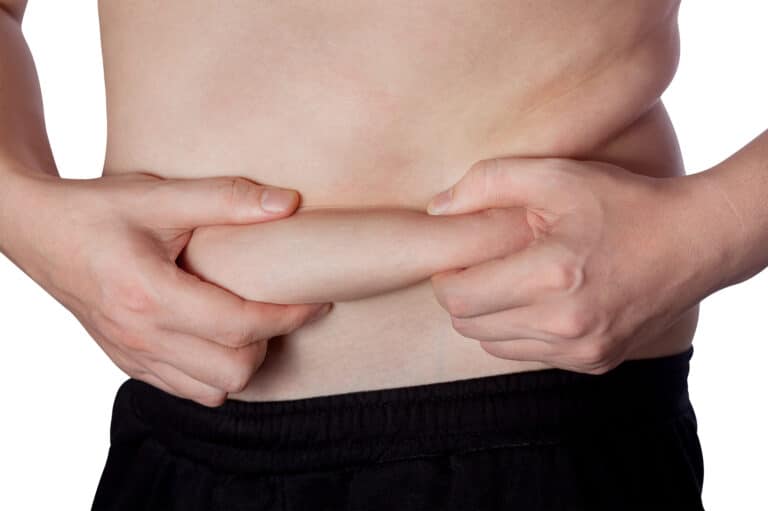Healthy habits will always be an essential part of everyday life when seeking fat reduction.
Doctors always encourage eating appropriate portions of whole foods, drinking plenty of water, and getting adequate sleep and exercise. But what if stubborn fat deposits remain after integrating all those healthy habits? Modern medical science to the rescue: noninvasive fat reduction treatment.
There’s a difference between being overweight and overfat. Researchers published a study in the journal Front Public Health that found that 91% of American adults have too much fat on at least certain sections of their body.1 That’s more than the percentage of overweight adults. The National Center for Health Statistics reports that number at 73.6% of the American adult population.2
Today, a growing number of fat reduction procedures are approved by the Food and Drug Administration to remove fat cells in targeted areas of the body. These different treatments are all designed for fat removal without surgery, employing new technology to treat fat deposits between the muscle and the skin.
Each treatment is different in how it works and what results you can expect. Patients want to know the fat reduction treatment price and whether insurance covers the bill. This handbook offers answers to many common questions about fat reduction treatment, outlined individually by each of the most popular procedures.
CoolSculpting
How It Works: Also known as cryolipolysis, CoolSculpting uses extreme cold to reduce fat pockets. It’s most often used on the abdomen, hips, thighs, upper back, arms, and under the buttock or chin.
The procedure, which includes using a paneled or cup-shaped device on top of the skin, takes about 35 to 60 minutes. Patients may feel freezing temperatures when the applicator is placed on the skin, but quickly goes numb. During the treatment, fat cells are frozen and destroyed. Surrounding tissue is not impacted because fat and skin freeze at different temperatures.
What Results to Expect: Estimated 25% reduction in the size of the fat bulge, with a minimal reshaping of the area. Patients tend to schedule one to two treatments and can see results within three months.
Average Cost: $1,481, according to the American Society of Plastic Surgery’s latest figures3
Would Insurance Cover This Procedure? Usually not
Laser Fat Reduction
How It Works: Also known as SculpSure, laser treatments for fat reduction use heat through a specific laser wavelength to treat subcutaneous fat.
Patients may feel a warming sensation, but constant cooling technology stops the skin from being damaged. Often used for the abdomen, it is usually a painless treatment that takes about 25 minutes per area.
What Results to Expect: Results can be seen in as little as six weeks. Surgeons report that the final results, which can be noted in about 12 weeks, can last, presuming no significant weight gain occurs.
Average Cost: $1,1143
Would Insurance Cover This Procedure? Unlikely unless there is a medical necessity
Radiofrequency Treatments
How It Works: Also known as Vanquish, radiofrequency fat removal treatments use magnetic waves with a machine that never even touches the body. It is ideal for treating larger body areas to heat and melt fat cells.
It often takes four to 10 sessions, usually scheduled a week apart, for the best results.
What Results to Expect: Visible about two months after their final treatment, patients can notice a clear decrease in the appearance of cellulite. Minimal downtime is needed.
Average Cost: Varies by region, between $200 and $7003
Would Insurance Cover This Procedure? No.
Ultrasound Fat Reduction
How It Works: This procedure uses the same sonic waves used during pregnancy and other medical treatments but is highly focused to break down the walls of the fat cells. With the treatment, the fat is released and metabolized naturally.
Two common names for this noninvasive treatment are UltraShape and Liposonix, and there are usually one to three treatments in the series. These appointments are spaced about two weeks apart.
What Results to Expect: Because it is using the body’s natural processes, results are gradual. The final results can take between six and 12 weeks.
Average Cost: $1,4813
Would Insurance Cover This Procedure? Most insurance companies do not.
Red Light Therapy
How It Works: Photonic lipolysis uses a specialized lamp to allow selected fat cells to open and release some of their contents. This gentle, non-surgical treatment has recently been approved by the FDA, often known as UltraSlim.
With treatments that take about 30 minutes, doctors usually use this therapy on the abdomen, hips, and thighs.
What Results to Expect: Results can be seen in just a matter of hours and usually improve with time. Patients typically have three or more treatments.
Average Cost: Ranges from $20 to $2003
Would Insurance Cover This Procedure? Some health center memberships include this therapy, which may allow insurance to cover it.
Tips For Choosing the Best Procedure for You
When researching different fat reduction price options and treatments, it’s important to consider these four tips for determining which is best for you.
- Know Your Goals: Be realistic about your expectations, especially if you do not plan to follow healthy habits to maintain the results.
- Consider the Budget: Some treatments are more expensive than others.
- Honor Personal Concerns: Each patient’s body is different, so results and reactions will also differ. Don’t compare yourself to anyone else.
- Speak with a Specialist: A trained and experienced cosmetic surgeon or physician wqill know which treatment is best for you. Come prepared with questions when you arrive at your first appointment.
To learn more about different treatments, browse the other articles today.
SOURCES:
- Front Public Health: “ The Prevalence of Overfat Adults and Children in the US.”
- The Centers for Disease Control and Prevention, National Center for Health Statistics: Obesity and Overweight.
- The American Society of Plastic Surgery: “ 2017 Average Surgeon/Physician Fees.”





